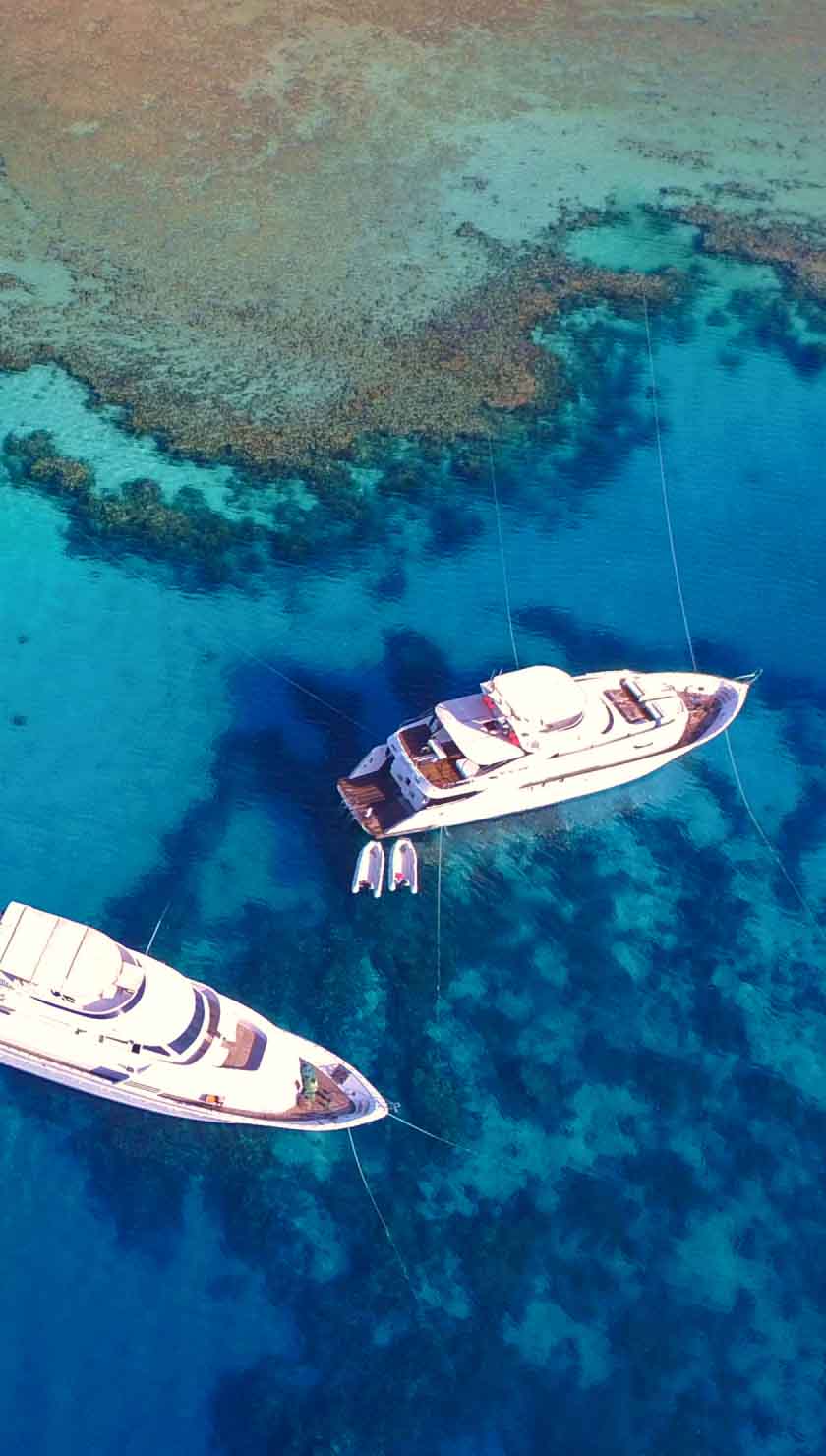Во время дайвинг-сафари по Большому Барьерному рифу вы посетите кристально чистые воды Кораллового моря, содержащего в себе миллиарды коралловых полипов, составляющих самый крупный живой организм на планете. Риф настолько велик, что виден из космоса, и вы не сможете исследовать его весь, даже если потратите на это всю жизнь. Дневные туры сюда вполне возможны, но это позволит вам лишь на несколько часов увидеть внутреннюю часть рифа, оставляя желать большего. Дайвинг-сафари же позволяют по-настоящему пережить подводные чудеса, поскольку плавание занимает несколько дней, а значит даёт возможность увидеть гораздо больше из того, что предлагает риф. Но даже во время дайвинг-сафари вы лишь прикоснётесь к настоящим чудесам, что несомненно заставить вас планировать следующий визит в самое ближайшее время!
Большой Барьерный риф под водой
Поскольку ББР считается крупнейшим рифом в мире, во время дайвинг-сафари вы можете ожидать увидеть практически всё что угодно: полный спектр рифовых рыб, включающий рыб-клоунов, цезий, рыб-бабочек, рыб-ангелов, форелей и морских нетопырей, плавающих на фоне поразительно красочных твёрдых и мягких кораллов.
Если искать достаточно долго (а лучше следовать за знающим своё дело дайвмастером), можно обнаружить удивительный микромир, например голожаберных всех цветов и мельчайших креветок. Вам вовсе не понадобится гид, чтобы обнаружить сотни кружащих рифовых акул, элегантных зелёных или головастых черепах и огромных скатов-мант. Вам лишь нужно убедиться, что вы не забыли захватить подводную камеру, чтобы запечатлеть их в естественной среде обитания. Также дайверы часто сообщают о ю увиденных морских змеях, каракатицах и леопардовых муренах.
Некоторый места для дайвинга предлагают уникальные развлечения, вроде Тресковой дыры в северной части Ленточного рифа - дома для огромных, но миролюбивых картофельных груперов и рыб-наполеонов. Все эти животные представлены круглогодично, но если вы погружаетесь с июня по декабрь, в качестве бонуса можно наблюдать малых полосатиков, горбатых китов, дельфинов и захватывающий нерест кораллов.
Наконец, помимо красивых рифов и коралловых садов вас могут заинтересовать расположенные возле южного отрога рифа затонувший корабль Йонгала - признанное одним из лучших в мире место для дайвинга.
Места для погружений и участки Большого Барьерного рифа
Было бы наивным описывать каждое место для дайвинга Большого Барьерного рифа, поскольку это заняло бы у нас всю жизнь. А поэтому ниже лишь несколько “самых-самых”, которые вы посетите во время своего дайвинг-сафари:
РИФ ОСПРИ знаменит своей видимостью в 40+ метров и почти гарантированными визитами акул из Северного Рога. Расположенный в Коралловом море и доступный для туров из Кэрнса, риф содержит множество малых пещер и сквозных пролётов, что делает дайвинг здесь весёлым для каждого.
ЛЕНТОЧНЫЙ РИФ лежит севернее Кэрнса и, ввиду изолированности, доступен только во время дайвинг-сафари. Представляет собой цепь из 10 отдельно стоящих рифов, предлагающих защищённые тёплые воды с нетронутой жизнью.
РИФ МИЛЛНА идеален для снорклинга и дайвинга, особенно для ночных погружений (зачастую встречаются спящие черепахи и крабы). Состоит из 3 крупных коралловых участков и расположен в 60 км от Кэрнса.
РИФ ФЛИННА считается одним из лучших коралловых садов Австралии. Это лучшее место для наблюдения за твёрдыми и мягкими кораллами, что может предложить ББР.
ТРЕСКОВАЯ ДЫРА таит в себе семейство гигантских картофельных груперов, которые позволят сделать вам чудесные фотографии с близкого расстояния (в мире не так много мест, где можно сделать селфи с рыбой, которая больше вас по размеру!). Не беспокойтесь, они всегда дружелюбны и любопытны, и обожают играть с дайверами. Также здесь часто можно встретить рыб-наполенов исполинских размеров. Тресковая дыра - часть Ленточного рифа.
ОСТРОВ ЯЩЕРИЦ - это национальный парк на одноимённом острове, расположенный на самом севере ББР. Тропический рай, идеальный для отдыха после пары дней погружений, а также оттачивания дайверских навыков в окружающих спокойных водах.
СЕВЕРНЫЙ РОГ - самая известная часть рифа Оспри, прославившаяся благодаря кормлениям акул, когда дайверы гарантированно видят этих подводных хищников, в том числе серых рифовых, шёлковых и белопёрых акул, а также рыб-молотов.
РИФ БУГЕНВИЛЛЬ можно посетить только в рамках дайвинг-сафари и строго когда позволяют погодные условия. Как результат - это один из самых нетронутых человеком рифов в Австралии, куда регулярно наведываются скаты-манты и черепахи.
ЗАТОНУВШИЙ КОРАБЛЬ ЙОНГАЛА уже давно признаны в качестве одного из лучших мест для дайвинга в мире. Затонувшее в 1911, судно осталось относительно нетронутым и, в то же время, служит домом самому невероятному разнообразию кораллов и морских обитателей во всём Большом Барьерном рифе.
Советы дайверам
Большой Барьерный риф предлагает дайвинг на любой вкус и уровень: от мягких и тёплых вод для новичков до пещер и сквозных пролётов для более опытных. Некоторые туры требуют наличие опыта в дайвинге, но для большинства нужны лишь минимальные навыки. Зачастую можно арендовать полный комплект снаряжения (обязательно проверьте это перед поездкой!), но не забудьте захватить свою сертификационную карточку. Также неплохой идеей будет взять журнал погружений, ведь вы наверняка захотите оставить память о своём путешествии. Видимость всегда хорошая - может достигать 40 метров, а температура воды варьируется от 22 до 30 градусов.
В Австралии разговаривают на английском языке, хотя экипажи на лодках часто говорят и на других языках. Валюта Австралии - австралийский доллар, который можно обналичить в одном из расположенных повсеместно, в том числе и на побережье, банкоматов,. Доступ к интернету, медицинской помощи и транспорту в Австралии на высочайшем уровне, но иметь туристическую страховку всё же не помешает.
Как добраться
Вне всяких сомнений, лучший способ исследовать ББР - это плыть сквозь Коралловое море во время одного из дайвинг-сафари по Австралии.
Liveaboard.com предлагает выбор из нескольких круизов на любой бюджет, большинство из которых отправляется из порта Кэрнс в Квинсленде. Также существует несколько малых региональных аэропортов (например, Таунсвилль, Рокхемптон, Остров ящериц), куда можно добраться из других частей Австралии, но самый лёгкий, экономичный и удобный способ посетить рифы - лететь напрямую в Кэрнс. Этот аэропорт предлагает хороший выбор из международных рейсов, позволяющих большинству гостей прибывать напрямую из-за рубежа. В то же время, в течение дня совершается много перелётов из основных хабов в Сиднее и Мельбурне, что удобно, если эти города - ваше первое место назначения в Австралии.












